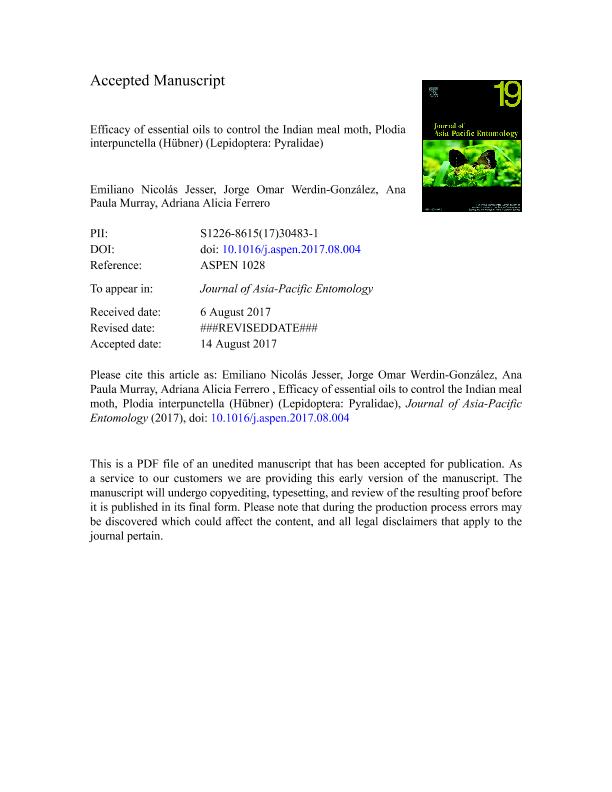Mostrar el registro sencillo del ítem
dc.contributor.author
Jesser, Emiliano Nicolás

dc.contributor.author
Werdin Gonzalez, Jorge Omar

dc.contributor.author
Murray, Ana Paula

dc.contributor.author
Ferrero, Adriana Alicia

dc.date.available
2018-08-15T22:11:12Z
dc.date.issued
2017-12
dc.identifier.citation
Jesser, Emiliano Nicolás; Werdin Gonzalez, Jorge Omar; Murray, Ana Paula; Ferrero, Adriana Alicia; Efficacy of essential oils to control the Indian meal moth, Plodia interpunctella (Hübner) (Lepidoptera: Pyralidae); Elsevier; Journal of Asia-Pacific Entomology; 20; 4; 12-2017; 1122-1129
dc.identifier.issn
1226-8615
dc.identifier.uri
http://hdl.handle.net/11336/55803
dc.description.abstract
Essential oils (EOs) have been recognized as an important source of biopesticides. This work investigated the chemical constituents and bioactivity of six essential oils namely lavender (Lavandula angustifolia Mill.), peppermint (Mentha piperita L.), geranium (Geranium maculatum L.), palmarosa (Cymbopogon martinii (Roxb.) Wats), eucalyptus (Eucalyptus globulus Labill.) and bergamot (Citrus bergamia Risso) against adults of the Indian meal moth, Plodia interpunctella, a cosmopolitan pest that infests a wide range of stored products. Analysis by gas chromatography coupled to mass spectrometry (GC–MS) revealed the presence of several compounds, mainly mono- and sesquiterpenes. The contact toxicity assay showed that the EO from palmarosa was the most toxic with a LD50 value of 22.8 μg cm− 2. The toxicity order was palmarosa > geranium > peppermint > lavender > bergamot > eucalyptus. In fumigant toxicity assay, the greatest effect was found with the EO from eucalyptus with a KT50 value of 8.34 min. The toxicity order was eucalyptus > peppermint > geranium = lavender > bergamot > palmarosa. The EO from palmarosa showed the highest residual activity when the insects were exposure to its volatiles constituents. Finally, all EOs produce sublethal activity promoting effects in the fecundity. In conclusion, the EOs could be used as potential biopesticides for P. interpunctella control.
dc.format
application/pdf
dc.language.iso
eng
dc.publisher
Elsevier

dc.rights
info:eu-repo/semantics/embargoedAccess
dc.rights.uri
https://creativecommons.org/licenses/by-nc-nd/2.5/ar/
dc.subject
Contact And Fumigant Toxicity
dc.subject
Essential Oils
dc.subject
Indian Meal Moth
dc.subject
Residual Activity
dc.subject
Sublethal Effects
dc.subject.classification
Otras Ciencias Biológicas

dc.subject.classification
Ciencias Biológicas

dc.subject.classification
CIENCIAS NATURALES Y EXACTAS

dc.title
Efficacy of essential oils to control the Indian meal moth, Plodia interpunctella (Hübner) (Lepidoptera: Pyralidae)
dc.type
info:eu-repo/semantics/article
dc.type
info:ar-repo/semantics/artículo
dc.type
info:eu-repo/semantics/publishedVersion
dc.date.updated
2018-08-10T16:23:10Z
dc.journal.volume
20
dc.journal.number
4
dc.journal.pagination
1122-1129
dc.journal.pais
Países Bajos

dc.journal.ciudad
Amsterdam
dc.description.fil
Fil: Jesser, Emiliano Nicolás. Consejo Nacional de Investigaciones Científicas y Técnicas. Centro Científico Tecnológico Conicet - Bahía Blanca. Instituto de Ciencias Biológicas y Biomédicas del Sur. Universidad Nacional del Sur. Departamento de Biología, Bioquímica y Farmacia. Instituto de Ciencias Biológicas y Biomédicas del Sur; Argentina. Universidad Nacional del Sur. Departamento de Biología, Bioquímica y Farmacia. Laboratorio de Zoología de Invertebrados II; Argentina
dc.description.fil
Fil: Werdin Gonzalez, Jorge Omar. Consejo Nacional de Investigaciones Científicas y Técnicas. Centro Científico Tecnológico Conicet - Bahía Blanca. Instituto de Química del Sur. Universidad Nacional del Sur. Departamento de Química. Instituto de Química del Sur; Argentina. Universidad Nacional del Sur. Departamento de Biología, Bioquímica y Farmacia. Laboratorio de Zoología de Invertebrados II; Argentina
dc.description.fil
Fil: Murray, Ana Paula. Consejo Nacional de Investigaciones Científicas y Técnicas. Centro Científico Tecnológico Conicet - Bahía Blanca. Instituto de Química del Sur. Universidad Nacional del Sur. Departamento de Química. Instituto de Química del Sur; Argentina
dc.description.fil
Fil: Ferrero, Adriana Alicia. Consejo Nacional de Investigaciones Científicas y Técnicas. Centro Científico Tecnológico Conicet - Bahía Blanca. Instituto de Ciencias Biológicas y Biomédicas del Sur. Universidad Nacional del Sur. Departamento de Biología, Bioquímica y Farmacia. Instituto de Ciencias Biológicas y Biomédicas del Sur; Argentina. Universidad Nacional del Sur. Departamento de Biología, Bioquímica y Farmacia. Laboratorio de Zoología de Invertebrados II; Argentina
dc.journal.title
Journal of Asia-Pacific Entomology
dc.rights.embargoDate
2019-01-01
dc.relation.alternativeid
info:eu-repo/semantics/altIdentifier/url/https://www.sciencedirect.com/science/article/pii/S1226861517304831
dc.relation.alternativeid
info:eu-repo/semantics/altIdentifier/doi/http://dx.doi.org/10.1016/j.aspen.2017.08.004
Archivos asociados
